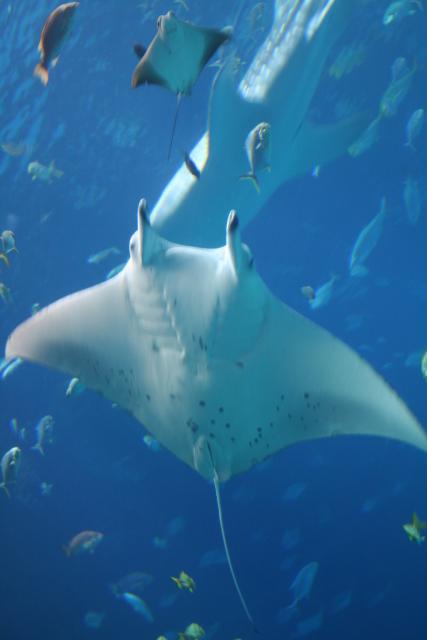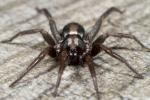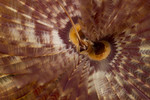shark
Turks and Caicos Explorer: Caribbean Reef Sharks (part 1)
ktuli — Mon, 10/29/2012 - 20:10
Ok - as I hinted at yesterday, I really struggled early in the week.
One of my mistakes was a classic bit of photographer hubris in that I thought I knew enough that adding a new piece of gear to my setup wouldn't be an issue and I'd just pick it up like a fish to water (sorry - terrible pun, I know!). Well, adding a second strobe to my setup certainly was not something I could do without first needing to learn some things - I should have tried out some dry photography with it in the housing and both strobes mounted before going on the trip.
The second issue I had was that there was quite a bit of rust build up. It had been a year since I'd done underwater photography (far too long!), and it took me a while to reacquaint myself with the setup and to remember what settings worked and which didn't. Again, some dry photography might have helped a little, but also just looking at old photos and seeing what worked and what settings were used would have gone a long way.
And the last issue was that despite knowing better, I was using the camera in a way that it just wasn't meant to operated. In particular, with the 100mm macro lens mounted, I certainly could focus on larger subjects that were a ways off, but I really shouldn't have been doing so. I know to reduce the water between me and my subject, and I know the ugly results I get when I fail to do so.
Despite that, and with a liberal amount of Photoshop work, here is my first set of Caribbean Reef Shark (Carcharhinus perezii) from the trip. Hopefully I have better ones to share later...
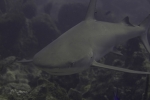 |
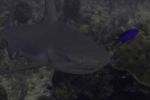 |
 |
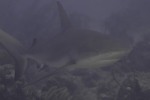 |
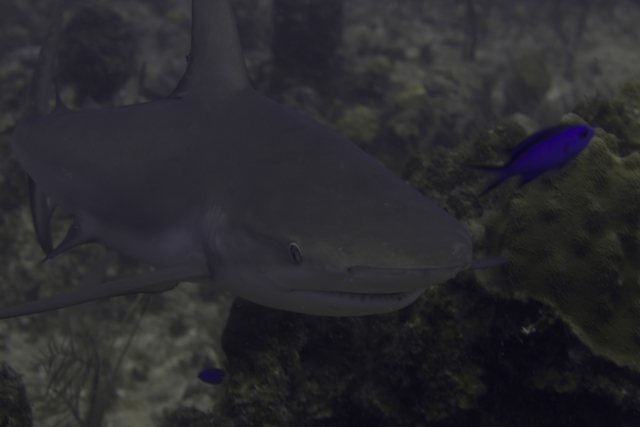 |
|||
Technical Data: Canon EOS 7D, Canon EF 100mm f/2.8L Macro IS USM, 1/200th sec at f/8. Image Stabilization on. ISO 320. Ikelite Housing and Port with dual Ikelite 161 Strobes in TTL Mode. Raw conversion in Photoshop CS5, Color cast removed in Photoshop Elements 9.
I kept these not only because I was able to partially salvage them, but also because I felt these were the first dives we were on where we saw "real" sharks. I know the nurse sharks we've seen before are quite real (and potentially dangerous in the wrong situation - ie: diver stupidity), but these are the first sharks with that classic shark body shape, and they weren't tiny little things... the ones we saw all week ranged in size from 6-10 feet long, and were bulky in weight to match... and fast. Just watching them swim was a treat - being in the water with such a beautiful creature and not being afraid (ok - mostly not afraid) of it was completely incredible.
- Bill
Turks and Caicos Explorer: Swim with Abby
ktuli — Wed, 10/24/2012 - 18:57
What up, fishes?
Ok! We're home from yet another fantastic scuba trip. This was quite the trip - lots of sharks, coral fluorescence, macro and wide-angle photography, our 100th dives, and.... video!
Technical Data: Canon EOS 7D, Canon EF-S 18-55mm f/3.5-5.6 II. Ikelite Housing and Port with dual Ikelite 161 Strobes in Video Light mode.
It is going to take me a little while to get through all the photos, so I figured I'd share a video to start things off. This friendly little (about 4 foot) nurse shark is lovingly named Abigale or Abby by the crew of our boat - the Turks and Caicos Explorer II. She visited us on many dives towards the end of the week while we were in French Cay, so I took this opportunity to follow her for a short swim.
Stay tuned as I have tons of photos and more videos to share!
- Bill
Whale Sharks and Diving
ktuli — Fri, 11/05/2010 - 16:13
We got some news this week - I can't really say if it is good news or bad news or maybe even false alarm news. Basically, we were told that it looked like our Wakatobi trip might have just disintegrated. At first, you might think that is terrible news, but not necessarily.
 I also received my copy of Scuba Diving magazine, and it had an article about locations for good whale shark diving.
I also received my copy of Scuba Diving magazine, and it had an article about locations for good whale shark diving.
Sorry - again, I'm using a photo that was not taken while diving, but rather from the dry side of an aquarium. This particular one is from the Geogia Aquarium where Anya and I have indeed dived.
So this got me thinking - I'd really love to see a whale shark in the wild. Fortunately, the article pointed out a place where whale shark diving is good in the January/February time frame - Mozambique. And some quick searching came up with some packages with Scuba Mozambique that look absolutely awesome.
The one package includes plenty of diving, but also a visit to Kruger National Park - which for someone like me who loves wildlife photography would be a vacation combination of lifetime!
So what seemed like bad new might end being transformed into good news. Then again, we went out to dinner with our dive instructor and learned that the Indonesia trip might re-materialize, which means it might be false alarm news. So we're just taking it in stride and know that one way or another we'll get to go on an incredible dive trip.
In the meantime, I'm taking the opportunity to browse through these old aquarium photos...
Technical Data: Canon EOS Digital Rebel XT, Canon EF-S 18-55mm f/3.5-5.6 II at 37mm, 1/30 sec at f/5, ISO 400. No post production. Geogia Aquarium, Atlanta, GA.
What Works: The vertical format works perfect here with this orientation of the whale shark, and the diagonal placement is very pleasing. The shark's head rests right on one of those hot-spots where the thirds rest in the shot, and the shape of the shark easily draws your eye along its body to its head. And though the shark's belly is pretty well featureless, this shot from below does place the shark in a position where you would encounter it in the wild as they are surface-swimming filter feeders, and so the placement of the shark in the upper two-thirds of the shot works nicely.
What Doesn't Work: The focus is a tad soft, which isn't exactly surprising with a constantly moving subject in dim lighting through water and acrylic.
That desire to go diving just keeps increasing every minute!
- Bill
Another Aquarium Photo
ktuli — Mon, 03/15/2010 - 20:40
Got a photo to share today from my small point and shoot camera.
It is still one of my favorite photos, and it goes along with yesterday's photo.

Technical Data: Canon PowerShot SD800 IS Digital Elph at 9.11mm, 1/20 sec at f/4, ISO Auto. No post production. Georgia Aquarium, Atlanta, GA.
I just love the silhouette of this whale shark with the rays of light shining around it.
It makes me want to go diving.
Soon.
- Bill
Let's Talk Convergence
ktuli — Sun, 03/14/2010 - 21:10
First off, this is not a great photo. It actually is a fairly bad photo. It has a major flaw with it.
Contrary to what this photo looks like, manta rays do not eat whale sharks (unless you're making a B rate sci-fi movie).
The problem with this photograph is known as a convergence or merging.
Basically, when I took this photo, I wasn't paying enough attention. My focus was all on the manta ray (and sadly even that isn't even in focus!).
I did not notice the whale shark entering into the background, and wait too long before tripping the shutter.
The result? A photo that makes it appear that the manta ray is trying to eat a whale shark. Trust me - like I said, that just doesn't happen. Both animals actually eat plankton, or basically small marine animals that aren't any larger than a quarter. Tiny shrimps and other small marine animals that float in the water.
I am going to make up some excuses for myself here...
First, all of the animals in the photograph are constantly moving - this is probably the biggest reason for convergences like this. When you have multiple subjects constantly moving and you are tracking to track one of the subjects, you sometimes lose track of the others and this can happen.
In addition, this photo was taken at the Georgia Aquarium's Ocean Voyager main viewing window. A 23 feet tall by 61 feet wide by 2 feet thick sheet of acrylic (currently the second largest aquarium viewing window in the world) in a darkened room. Multiple factors that all team up for difficult photography.
But in reality, none of these are excuses for converging subjects.
Keep an eye out for this in your own photos and try to avoid it. Definitely don't let it happen with stationary elements in your photos. It is distracting, and quite often ruins photos.
Technical Data: Canon EOS Digital Rebel XT, Canon EF-S 18-55mm f/3.5-5.6 II at 55mm, 1/15 sec at f/5.6, ISO 400. No post production. Georgia Aquarium, Atlanta, GA.
So enough beating up on my own photography for a bit... now I am going to babble a bit about the trip itself.
This particular visit to the aquarium was our second trip. The first time the aquarium did not have the manta ray. However, this second time, we were scuba certified, so we took advantage of the aquarium's Journey with Gentle Giants program.
Yeah, some might call it cheating, but Anya and I have gotten to swim with whale sharks, manta rays, hammerheads, and a ton of other stuff. And as fascinating as whale sharks are, I've always loved manta rays.
During our dive, there was a point at which the manta ray swam no more than a couple feet above me. I managed to roll over on my back and swim underneath it and watch as it glided through the water above me. Has they not had strict rules about touching the animals, I could have easily reached up and ran my hand along its belly.
On one hand, I wished I could have had a camera with me, but on the other hand, I am glad that I didn't so I could just experience the dive.
But underwater photography is something I'll be getting into more and more. Now if only someone would donate a couple Ikelite housings to the cause...
Ok - that is a long enough post for today. I'm going to wander off to look through a new Coral Reef photo book I bought over the weekend.
Enjoy the remainder of your weekend (or here's hoping your Monday is starting off smoothly).
- Bill

